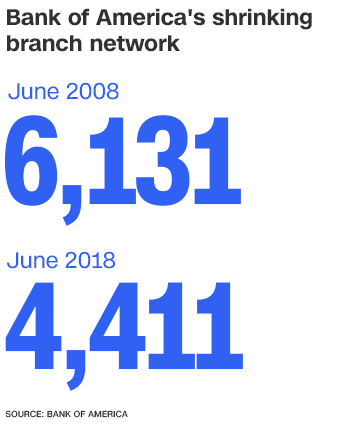
The future of banking is here -- and it's mobile.
Bank of America (BAC) announced on Monday that deposits made on mobile devices like smartphones and tablets are outpacing those made at branches for the first time.
Customers logged into Bank of America's mobile app 1.4 billion times last quarter.
The rapid adoption of mobile banking has allowed big banks to massively shrink the number of expensive branches they operate.
Bank of America's vast network of branches fell to 4,411 at the end of June, compared with 4,542 a year ago. The company has 1,720 fewer branches than it did in June 2008. That's a 28% drop.
At the same time, Bank of America's active mobile banking users jumped by 11% to 25.3 million over the past year.
It's not just Millennials turning to their smartphones for banking.
"The common theory is that this is all young kids," Bank of America CEO Brian Moynihan told analysts on Monday. "But there's not enough young kids in anybody's customer base to drive this kind of activity. It has broadened out dramatically."
Moynihan even highlighted "high" levels of mobile banking activity by "grandparents."

Related: Wells Fargo finds even more customers that it overcharged
Big banks have plowed hundreds of millions of dollars into new technology aimed at luring customers online.
For instance, Bank of America launched in April an artificial intelligence-driven financial assistant named Erica. The number of Erica users has already reached 2 million.
Bank of America has also teamed up with Wells Fargo (CBEAX), JPMorgan Chase and other big banks to build Zelle, a digital payment service that rivals PayPal (PYPL) and Venmo. More than $25 billion moved through Zelle during the first quarter, up 15% from the final three months of 2017.
Traditional banks are under pressure from Silicon Valley to innovate. Amazon, Apple (AAPL) and Facebook (FB) are all reportedly experimenting with pushes into finance. Amazon (AMZN), for instance, is considering adding a person-to-person payments feature to its popular Alexa virtual assistant, The Wall Street Journal reported in April.
Related: Are Apple, Amazon and Facebook the future of banking?
Shutting branches allows traditional banks to cut costs. Bank of America's non-interest expenses dropped by 5% last quarter, the most in two years.
It's not just Bank of America shrinking its branch network. JPMorgan (JPM), the No. 2 US bank by branches, trimmed its count by 2% over the past year to 5,091.
Wells Fargo still has 5,751 branches, but the bank shut more than 200 branches last year. In January, Wells Fargo announced plans to pull the plug on another 800 locations by 2020. The bank also agreed in June to sell all of its branches in Indiana, Michigan and Ohio.
Big banks aren't giving up on branches entirely. Bank of America plans to open more than 500 new branches across the United States over the next four years. After recently expanding into Denver, Minneapolis and Indianapolis, Bank of America is moving into Ohio and Pittsburgh.
A Bank of America spokeswoman said, however, that the plan to build new branches and renovate others may not increase the company's overall branch count.
In other words, Bank of America may continue to shut more branches than it opens.

